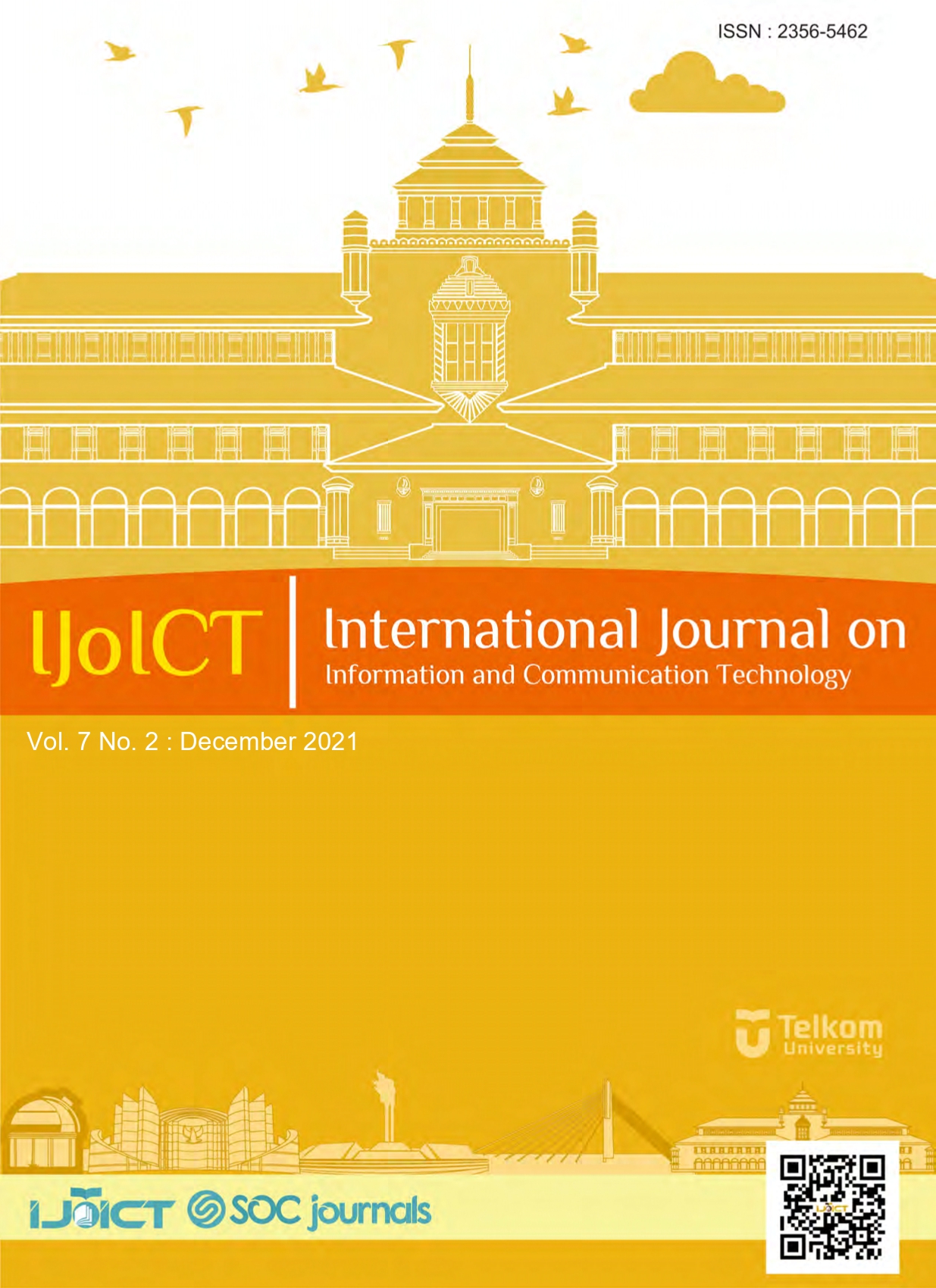STL Decomposition and SARIMA Model: The Case for Estimating Value-at-Risk of Covid-19 Increment Rate in DKI Jakarta
DOI:
https://doi.org/10.21108/ijoict.v7i2.553Keywords:
Coverage Probability, Covid-19, Extreme Value, SARIMA, Seasonal, STL, Value-at-RiskAbstract
In this research, we propose an extreme values measure, the Value-at-Risk (VaR) based Seasonal Trend Loess (STL) Decomposition and Seasonal Autoregressive Integrated Moving Average (SARIMA) models, which is more sensitive to the seasonality of extreme value than the conventional VaR. We consider the problem of the seasonality and extreme value for increment rate of Covid-19 forecasting. For stakeholder, government and regulator, VaR estimation can be implemented to face the extreme wave of new positive Covid-19 in the future and minimize the losses that possibly affected in term of financial and human resources. Specifically, the estimation of VaR is developed with the difference lies on parameter estimators of STL and SARIMA model. The VaR has coverage probability as well as close 1-α. Thus, we propose to set α as parameter to estimate VaR. Consequently, the performance of VaR will depend not only on parameter model but also α. Our aim estimates VaR with minimum α based on correct VaR value. Numerical analysis is carried out to illustrate the estimative VaR.
Downloads
References
Tim Relawan KawalCOVID-19, "Grafik Interaktif untuk Data per Provinsi," Indika Foundation, 1 March 2020. [Online]. Available: https://kawalcovid19.id/. [Accessed 15 April 2021].
P. Jorion, Value at Risk : The New Benchmark for Managing Financial Risk, Second Edition, New York: The McGraw-Hill Companies, Inc, 2002.
A. A. Rohmawati and K. Syuhada, "Value-at-Risk and Expected Shortfall Relationship," International Journal of Applied Mathematics and Statistics, vol. 53, no. 5, pp. 211-215, October 2015.
A. B. Rejeb, O. B. Salha and J. B. Rejeb, "Value-at-Risk Analysis for the Tunisian Currency Market: A Comparative Study," International Journal of Economics and Financial Issues, vol. 2, no. 2, pp. 110-125, 2012.
R. J. Hyndman and G. Athanasopoulos, Forecasting: Principles and Practice, 2nd ed., Melbourne: OTexts, 2018.
D. Mulya, Y. Asdi and F. Yanuar, "Penerapan Metode Holt Winter dan Seasonal ARIMA Pada Peramalan Perkembangan Wisatawan Mancanegara Yang Datang ke Indonesia," Jurnal Matematika UNAND, vol. VI, pp. 29-36, 2017.
S. Bang, R. Bishnoi, A. S. Chauhan, A. K. Dixit and I. Chawla, "Fuzzy Logic based Crop Yield Prediction using Temperature and Rainfall parameters predicted through ARMA, SARIMA, and ARMAX models," 2019 Twelfth International Conference on Contemporary Computing (IC3), pp. 1-6, 19 September 2019.
J. Buhl, C. Liedtke, S. Schuster and K. Bienge, "Predicting the Material Footprint in Germany between 2015 and 2020 via Seasonally Decomposed Autoregressive and Exponential Smoothing Algorithms," Resources 2020, vol. 9, p. 125, 25 October 2020.
A. Haritsah, Implementasi Model STL Seasonal Trend Decomposition Based On Loess dan ARIMA Untuk Prediksi Konsentrasi Kualitas Udara, Surabaya: Institut Teknologi Sepuluh November, 2015.
D. A. I. Muruddani and A. Purbowati, "Pengukuran Value At Risk Pada Aset Tunggal dan Portofolio Dengan Simulasi Monte Carlo," Media Statistika, vol. 2, pp. 93-104, December 2009.
P. Utomo and A. Fanani, "Peramalan Jumlah Penumpang Kereta Api di Indonesia Menggunakan Metode Seasonal Autoregressive Integrated Moving Average (SARIMA)," Jurnal Mahasiswa Matematika ALGEBRA, vol. 1, pp. 169-178, 2020.
H. Wiguna, Y. Nugraha, F. R. R., A. Andika, J. I. Kanggarawan and A. L. Suherman, "Kebijakan Berbasis Data: Analisis dan Prediksi Penyebaran COVID-19 di Jakarta dengan Metode Autoregressive Integrated Moving Average (ARIMA)," Jurnal Sistem Cerdas, vol. 03, no. 02, pp. 74-83, 2020.
A. K. Rachmawati and S. D. Miasary, "Peramalan Penyebaran Jumlah Kasus Virus Covid-19 Provinsi Jawa Tengah dengan Metode Arima," Zeta - Math Journal, vol. 6, no. 1, May 2021.
Supriatun, I. Solihati, P. R. Arum and T. T. W. Utami, "Peramalan Jumlah Kasus Covid-19 di Semarang Menggunakan Metode Autoregressive Integrated Moving Average," Prosiding Seminar Edusainstech, vol. 4, 2020.
K. E. ArunKumar, D. V. Kalaga, C. M. S. Kumar, G. Chilkoor, M. Kawaji and T. M. Brenza, "Forecasting the dynamics of cumulative COVID-19 cases (confirmed, recovered and deaths) for top-16 countries using statistical machine learning models: ARIMA and SARIMA," Appl Soft Comput., vol. 103, no. 107161, May 2021.
J. E. Hanke and D. W. Wichern, Business Forecasting, 8th Edition, New York: New Jersey: Pearson, Prentice Hall, 2005.
R. B. Cleveland, W. S. Cleveland, J. E. McRae and I. Terpenning, "STL: A Seasonal-Trend Decomposition Procedure Based on Loess," Jurnal of Official Statistics, vol. 6, pp. 3-73, 1990.
A. B. Wijaya, C. Dewi and B. Rahayudi, "Peramalan Curah Hujan Menggunakan Metode High Order Fuzzy Time Series Multi Factors," Jurnal Pengembangan Teknologi Informasi dan Ilmu Komputer, vol. 2, no. 3, pp. 930-939, March 2018.
Downloads
Published
How to Cite
Issue
Section
License
Manuscript submitted to IJoICT has to be an original work of the author(s), contains no element of plagiarism, and has never been published or is not being considered for publication in other journals. Author(s) shall agree to assign all copyright of published article to IJoICT. Requests related to future re-use and re-publication of major or substantial parts of the article must be consulted with the editors of IJoICT.








.png)

.jpg)




